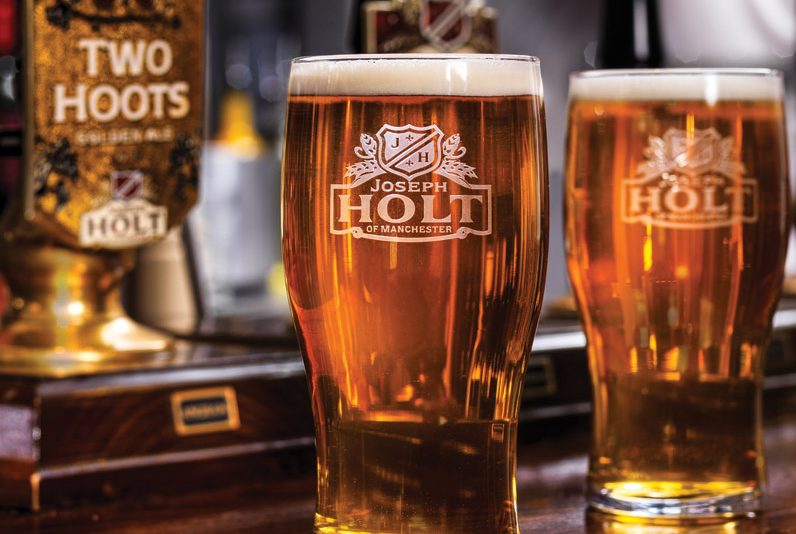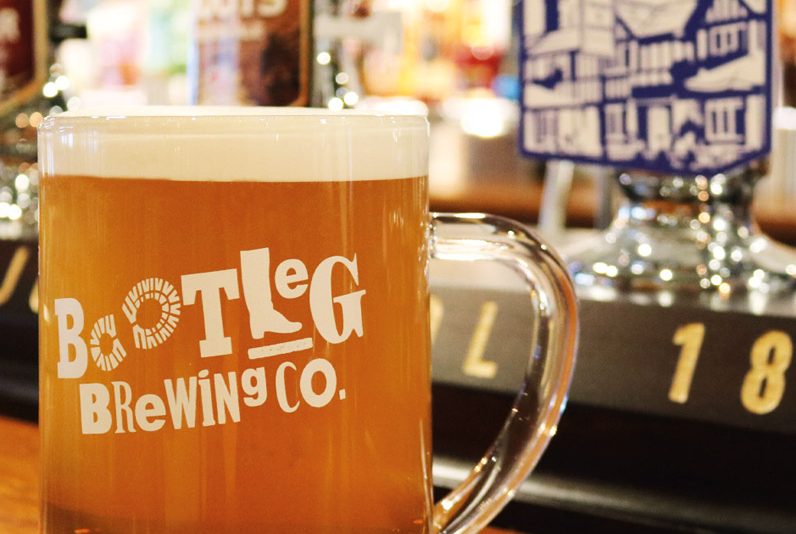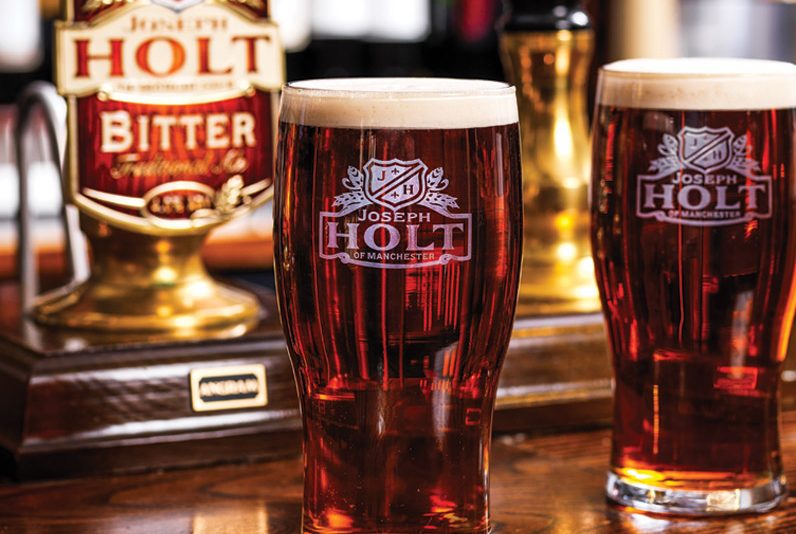Cask Ale Guide 2023
Cask ale is without doubt the patron of British brewing. It’s rich history dates back through the Middle Ages and right up to 2023 where the art of brewing and serving cask ale lives on.
There’s no denying that cask ale started to dwindle in the mid-1900s, sparking the creation of the Campaign for Real Ale (CAMRA) in 1971. We’ve since seen a renaissance period in cask beer from CAMRA’s initial quest for better quality ale.
In recent years there has been a swelling of interest in different beer types and styles with a variety of adventurous ingredients making their way into brews. This started to halt the decline in the overall beer market, although cask ale still faces an uphill battle. Statistics show a recent drop in cask ale sales from 2.4m hectolitres to 1.1m hectolitres. Despite the drop, Joseph Holt are as passionate as ever about brewing and selling cask ale in all of our pubs!
A few misconceptions have been picked up over the years on what cask ale is, how it tastes, looks and the market it caters for, largely due to quality issues and poor cellar management. We answer some of these misunderstandings in a FAQ-type section at the bottom of this article.
This Complete Guide to Cask Ale aims to give you the full picture, including what cask ale is, it’s main qualities, how it’s brewed, conditioned, looked after and why it doesn’t live up to the misconceptions.
What is cask ale?
So, what is cask ale exactly?
Cask ale is essentially an unfiltered, unpasteurised ‘live’ product containing yeast that is served from the cask container where it’s gently matured by secondary fermentation. When conditioned and managed correctly, the yeast in the cask settles to the bottom, leaving a clear, often bright, full-flavoured and naturally carbonated beer to be served from the handpump.
Cask, or Real Ale as it was coined by CAMRA in the 1970s, is a carefully crafted product – a true ‘craft beer’ if you will. Getting it right requires love, care, attention and skill, especially after the beer has been racked in a cask.
It’s this excellent stewardship that sets cask apart and makes it distinct from its kegged cousin, which doesn’t require special after-care once it’s been filtered, potentially pasteurised and injected with carbon dioxide or nitrogen prior to serving.
Cask ale is sometimes known as ‘cask-conditioned’ beer due to the vital process it goes through, which we’ll get into later. You can have a look at some of our cask ale here.
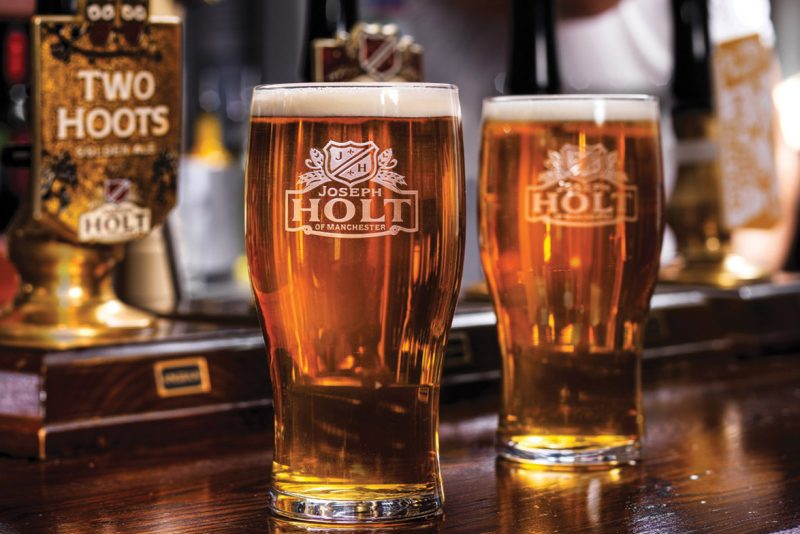
Why put ale in a cask?
A cask is a large container typically used to store beverages. Cask use dates back thousands of years where it was the only way of storing beer and wine. Before metal kegs were introduced into beer brewing in the 1950s, wooden casks were the predominant way of storing and moving beer from the brewery to location.
In fact, breweries such as Joseph Holt had our own skilled cask-makers, known as coopers, who were still active at our brewery up until the mid-1980s.
Casks and other beer containers are now almost exclusively made from metal, mainly stainless steel, making them easier to clean, maintain and reuse. Some casks are also being replaced by kegs to serve draught beer. You can learn more about the difference between cask and keg here.
Cask sizes: How big is a cask barrel?
The word ‘cask’ has evolved into an over-arching term for a container of any size used for cask-conditioned ale. The word cask has also become almost interchangeable with ‘barrel’, but as shown below, a barrel is actually a specific size of cask.
- Hogshead = 54 gallons / 432 pints
- Barrel = 36 gallons / 288 pints
- Kilderkin = 18 gallons / 144 pints
- Firkin = 9 gallons / 72 pints
- Pin = 4.5 gallons / 36 pints
Of the sizes used now, firkins are the most common in the brewing industry, followed by pins and kilderkins. As cask beer has a fairly short window of use to get maximum quality, venues need to consider the size of cask they order in to avoid waste and bad beer.
At Joseph Holt, our draymen deliver our cask ale in barrels, kilderkins and firkins. We only recently stopped delivering in hogsheads where we were one of the last family breweries to do so.
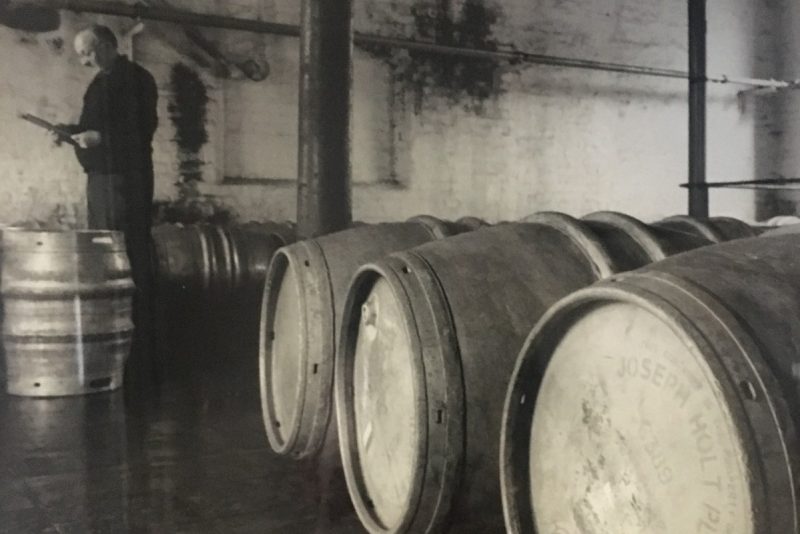
How is cask ale brewed?
The brew begins by grinding down malted barley to break open the grains and expose the central starch.
The remaining product, called grist, is mixed with hot water (known as liquor to brewers) in a container, such as a mash tun, for around 75 minutes where the hot water activates the enzymes within the grist and the starchy centre starts to convert into fermentable sugar. Different enzymes work at different temperatures, so breweries can control the type of sugars produced depending on the type of beer they want to create – dry, sweet, full-bodied etc.
The resulting sugary solution, known as wort, is separated from the grain husks through the bottom of the mash tun, where the husk layer helps to act as a natural filter. Once all the wort has passed through, the grain is collected and used by farms as animal feed.
Next, the wort is transferred to a large vessel called a copper, although not all ‘coppers’ are actually made of copper anymore. Here it’s boiled for an hour to sterilise the brew and the first set of hops are added. Hops added to the wort at this stage impart the all-important bitterness to the final beer, whereas hops added later refine aroma and flavour depth.
The wort is quickly cooled to around 18oC for ales and 12oC for lagers and moved to a stainless steel fermentor where the yeast is pitched. The type of yeast used, of which there are many types, is crucial to the type of beer. For cask ale, an ale yeast is pitched although this is not always the case if you’re brewing a different type of cask, where a different type of yeast is used. We have our own in-house yeast strains.
Ale yeasts are top-fermenting operators, creating a thick layer of froth in the fermentor. Don’t be deceived though, underneath this the beer is developing nicely – the yeast is consuming the sugars and releasing alcohol, carbon dioxide and a variety of flavours.
After fermentation, which generally takes between 2-4 days, the young beer is matured for the rest of the week to allow for full flavour development and a smooth finish. It is then ready to fill, or rack, into casks where the ale will enter its next, all important stage.
Joseph Holt Cask Ale
How to look after and condition cask ale properly
As mentioned, the ale racked into casks is a live product – it hasn’t been pasteurised or filtered, still contains yeast and hasn’t had any external carbon dioxide added.
At this point, the settling process is sped up by adding a fining agent. One of the most common fining agents used in the industry is isinglass. The positive charge of isinglass attracts the negative charge of the yeast, creating a heavier material which settles at the bottom of the cask, helping to form a clear, bright beer.
Not all cask ale is served in a clarified state. Some breweries produce unfined beer without isinglass or any other finings, creating a hazy, cloudy ale.
As the beer leaves the brewery in cask, it continues the conditioning process with the yeast working its way through the remaining sugars, altering the alcohol levels and producing a natural carbonation. It’s during this secondary phase where the beer matures and develops into subtle flavours that characterise a perfect pint of cask ale.
Looking after cask ale in the cellar
On the day of delivery to a pub or bar cellar, a cask must be stillaged first before anything else.
A stillage is a device where a cask of ale is positioned and prepared for serving. In some old-school pubs, casks may still be stillaged on wooden wedges but newer mechanical stillages now exist with springs that gently tilt the cask when the time is right.
Correct stillaging involves positioning the cask so all is level and unmoving. Unlike a keg which is simply stood up, a cask is positioned on its belly with the shive on top (where the bung is hammered) and keystone (where the tap will be inserted) vertically aligned.
Stillaging allows the sediment to settle to the bottom of the cask into the belly and below the tapping point – once this happens it shouldn’t be disturbed again, otherwise the sediment will come into suspension again. It also creates an airspace directly below the shive, which will encourage good venting.
After 24 hours, the cask should have settled and reached the correct cellar temperature – between 11-13oC. Now the cask is ready to tap and vent.
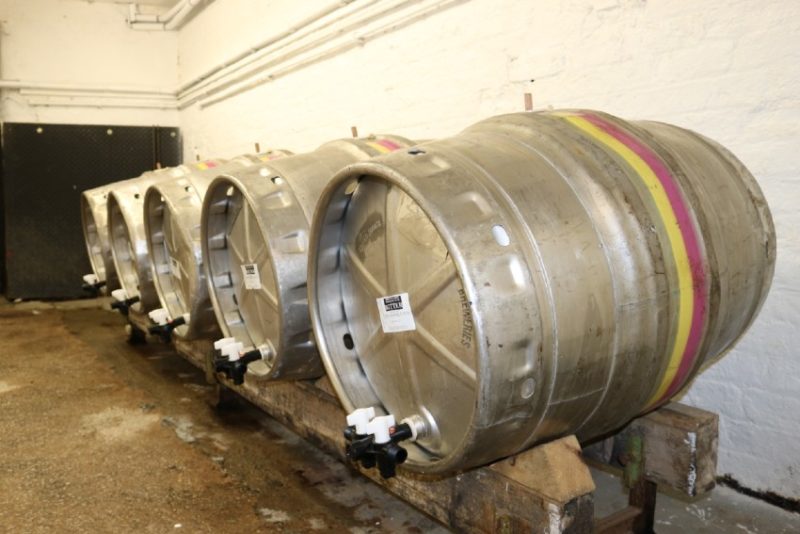
How to tap and vent a cask
With the cask in position, a hole is made in the shive and a soft, porous peg is inserted. This is left for around 48-72 hours as the conditioning process continues to work its magic on the beer within. Once conditioned, the soft peg is replaced with a hard, non-porous peg.
Tapping the cask also takes place at the same time as venting. Here, a clean tap is driven through the keystone with a mallet, ready to attach a hop filter and beer pipe. Before the pipe is attached, it’s important to check the beer for clarity, aroma and taste by removing the peg and drawing a sample off. Only then attach a beer pipe and draw through a clean beer line to take a sample at the bar.
If all is looking tip-top, you’re ready to start serving. Remove the peg before trading and replace with a hard peg between trading sessions helps to prevent the loss of too much carbon dioxide.
It’s crucial to remember that once your cask has started to sell, it will only keep good for around 3 days. Do not serve beer in less than premium condition! To continue selling good quality cask ale, it’s necessary to have your next casks settled, tapped, vented and ready to go.
Tilting the cask
As your ale starts to be supped at the bar, the cask in the cellar will need to be tilted to maximise beer yield. If you have a self-tilting mechanical stillage you don’t have to worry about this, but for those operating a traditional stillage, you’ll have to start tilting your cask when it’s around two-thirds full.
Tilt by approximately 20 degrees so the back is about 7cm (2-3 inches) higher than the front. This will help minimise sediment disturbance and ensure all your beer is in great condition. Don’t tilt the cask when it’s nearly full or empty.
Common Myths of Cask Ale
Misconception 1: “It’s warm”
Nope. This is perhaps the biggest misconception of cask ale and British beer. Cask ale should not be warm or served at room temperature. It should in fact be gently chilled and served at ‘cellar temperature’, which is 11-13oC. This becomes problematic when pubs and other venues don’t follow the correct guidelines and storing conditions.
Misconception 2: “It’s just an old man’s drink”
Back in the day, cask ale was the tipple of choice for working men having a pint in a back-street pub. However, the scene has certainly changed in recent years and cask ale is growing in popularity with younger drinkers. In fact, real ale’s market share is increasing within the general beer market. Younger drinkers, both men and women, want to try a greater variety of beers, including cask, which offers more complex flavours but usually at a lower ABV than kegged lagers. Local real ales are also on the rise and consumers like to support independent breweries over the big corporates. All this has combined to see a renaissance of cask ale which can no longer be claimed as an ‘old man’s drink’.
Misconception 3: “It’s flat”
When conditioned correctly, cask ale should offer a natural carbonation from the yeast which gives off carbon dioxide. This carbonation is subtle, producing fine silky bubbles and leaving a smooth finish as opposed to a keg ale which uses a higher gas level. A good pub manager who looks after their cellar correctly, should recognise when their cask ale reaches peak condition and is ready to serve. Serving a beer too early or keeping it on for too long after it has been tapped severely risks the ale quality, which can wrongly create a bad impression of the beer.
Misconception 4: “It’s sour”
The ale has probably been on sale too long. When a cask has been on for more than 3 days, quality will rapidly decrease and the beer will take on vinegar-like qualities, which is not desirable in any way, shape or form.
Misconception 5: “It’s brown and murky”
Cask ale can take many forms. The cask method can be used to produce bitter, pale ale, golden ale, mild, IPA, stout, porters and other styles of beer. As I’m sure you’re aware, not all of these ales are brown and murky!
So there you have it, your complete guide to cask beer in 2022. All that’s left now is to find a good pub serving well-managed cask ale and grab yourself a pint of the good stuff.

